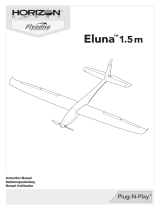E-flite UMX A-10 Thunderbolt II Owner's manual
- Category
- Remote controlled toys
- Type
- Owner's manual
This manual is also suitable for
E-flite UMX A-10 Thunderbolt II is an exceptional RC aircraft that combines agility and precision, making it an ideal choice for experienced pilots seeking thrilling aerial maneuvers. Its compact size and lightweight construction allow for precise control and effortless handling in a wide range of flying conditions.
Crafted with durable materials, this aircraft can withstand the rigors of demanding flight while ensuring long-lasting performance. The powerful brushless motors deliver impressive speed and acceleration, enabling you to execute exhilarating maneuvers with ease.
Equipped with an advanced receiver and AS3X technology, the E-flite UMX A-10 Thunderbolt II provides enhanced stability and control, making it suitable for a variety of flying styles. The integrated telemetry system provides valuable real-time data, allowing you to monitor critical parameters such as battery voltage, motor temperature, and more.
E-flite UMX A-10 Thunderbolt II is an exceptional RC aircraft that combines agility and precision, making it an ideal choice for experienced pilots seeking thrilling aerial maneuvers. Its compact size and lightweight construction allow for precise control and effortless handling in a wide range of flying conditions.
Crafted with durable materials, this aircraft can withstand the rigors of demanding flight while ensuring long-lasting performance. The powerful brushless motors deliver impressive speed and acceleration, enabling you to execute exhilarating maneuvers with ease.
Equipped with an advanced receiver and AS3X technology, the E-flite UMX A-10 Thunderbolt II provides enhanced stability and control, making it suitable for a variety of flying styles. The integrated telemetry system provides valuable real-time data, allowing you to monitor critical parameters such as battery voltage, motor temperature, and more.




















-
 1
1
-
 2
2
-
 3
3
-
 4
4
-
 5
5
-
 6
6
-
 7
7
-
 8
8
-
 9
9
-
 10
10
-
 11
11
-
 12
12
-
 13
13
-
 14
14
-
 15
15
-
 16
16
-
 17
17
-
 18
18
-
 19
19
-
 20
20
E-flite UMX A-10 Thunderbolt II Owner's manual
- Category
- Remote controlled toys
- Type
- Owner's manual
- This manual is also suitable for
E-flite UMX A-10 Thunderbolt II is an exceptional RC aircraft that combines agility and precision, making it an ideal choice for experienced pilots seeking thrilling aerial maneuvers. Its compact size and lightweight construction allow for precise control and effortless handling in a wide range of flying conditions.
Crafted with durable materials, this aircraft can withstand the rigors of demanding flight while ensuring long-lasting performance. The powerful brushless motors deliver impressive speed and acceleration, enabling you to execute exhilarating maneuvers with ease.
Equipped with an advanced receiver and AS3X technology, the E-flite UMX A-10 Thunderbolt II provides enhanced stability and control, making it suitable for a variety of flying styles. The integrated telemetry system provides valuable real-time data, allowing you to monitor critical parameters such as battery voltage, motor temperature, and more.
Ask a question and I''ll find the answer in the document
Finding information in a document is now easier with AI
Related papers
-
E-flite EFLU6350 Owner's manual
-
E-flite EFLU3750 Owner's manual
-
E-flite EFLU6550 Owner's manual
-
E-flite EFLU16450 User manual
-
E-flite EFL300500 Owner's manual
-
E-flite EFL12575 Owner's manual
-
E-flite EFL30075 Owner's manual
-
E-flite EFL78500 Owner's manual
-
E-flite Extra 300 1.3m Owner's manual
-
E-flite EFL01350 Owner's manual
Other documents
-
Horizon Hobby Pawnee Brave Night Flyer AS3X User manual
-
Blade BLH1200 Owner's manual
-
ParkZone Sukhoi SU-29MM User manual
-
Spektrum SLT6 User manual
-
ParkZone VisionAire BNF User manual
-
Spektrum Smart S1100 AC Charger Owner's manual
-
ParkZone Ultra Micro Mosquito Mk VI BNF User manual
-
Blade ST-10+ User manual
-
Spektrum Alpha-6 Stability System User manual
-
 Flyzone FLZA3075 Owner's manual
Flyzone FLZA3075 Owner's manual




















